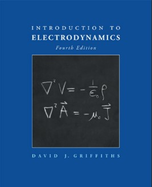Solution Found!
A rotating electric dipole can be thought of as the
Chapter 11, Problem 4P(choose chapter or problem)
Problem 4P
A rotating electric dipole can be thought of as the superposition of two oscillating dipoles, one along the x axis and the other along the y axis (Fig. 11.7), with the latter out of phase by 90˚:
Using the principle of superposition and Eqs. 11.18 and 11.19 (perhaps in the form suggested by Prob. 11.2), find the fields of a rotating dipole. Also find the Poynting vector and the intensity of the radiation. Sketch the intensity profile as a function of the polar angle θ, and calculate the total power radiated. Does the answer seem reasonable? (Note that power, being quadratic in the fields, does not satisfy the superposition principle. In this instance, however, it seems to. How do you account for this?)
Reference equation 11.18
Reference equation 11.19
Reference prob 11.2
Equation 11.14 can be expressed in “coordinate-free” form by writing Do so, and likewise for Eqs. 11.17, 11.18. 11.19, and 11.21.
Questions & Answers
QUESTION:
Problem 4P
A rotating electric dipole can be thought of as the superposition of two oscillating dipoles, one along the x axis and the other along the y axis (Fig. 11.7), with the latter out of phase by 90˚:
Using the principle of superposition and Eqs. 11.18 and 11.19 (perhaps in the form suggested by Prob. 11.2), find the fields of a rotating dipole. Also find the Poynting vector and the intensity of the radiation. Sketch the intensity profile as a function of the polar angle θ, and calculate the total power radiated. Does the answer seem reasonable? (Note that power, being quadratic in the fields, does not satisfy the superposition principle. In this instance, however, it seems to. How do you account for this?)
Reference equation 11.18
Reference equation 11.19
Reference prob 11.2
Equation 11.14 can be expressed in “coordinate-free” form by writing Do so, and likewise for Eqs. 11.17, 11.18. 11.19, and 11.21.
ANSWER:
Problem 4P
A rotating electric dipole can be thought of as the superposition of two oscillating dipoles, one along the x axis and the other along the y axis (Fig. 11.7), with the latter out of phase by :
Using the principle of superposition and Eqs. 11.18 and 11.19 (perhaps in the form suggested by Prob. 11.2), find the fields of a rotating dipole. Also find the Poynting vector and the intensity of the radiation. Sketch the intensity profile as a function of the polar angle ?, and calculate the total power radiated. Does the answer seem reasonable? (Note that power, being quadratic in the fields, does not satisfy the superposition principle. In this instance, however, it seems to. How do you account for this?)
Reference equation 11.18
Reference equation 11.19
Reference prob 11.2
Equation 11.14 can be expressed in “coordinate-free” form by writing . Do so, and likewise for Eqs. 11.17, 11.18. 11.19, and 11.21.
Step by Step Solution
Step 1 of 8
The expression for the gradient of variable f in the polar coordinates can be written as:
The expression for the potential in terms of Cartesian coordinates can be written as:
The expression for the dipole moment can be written as:
